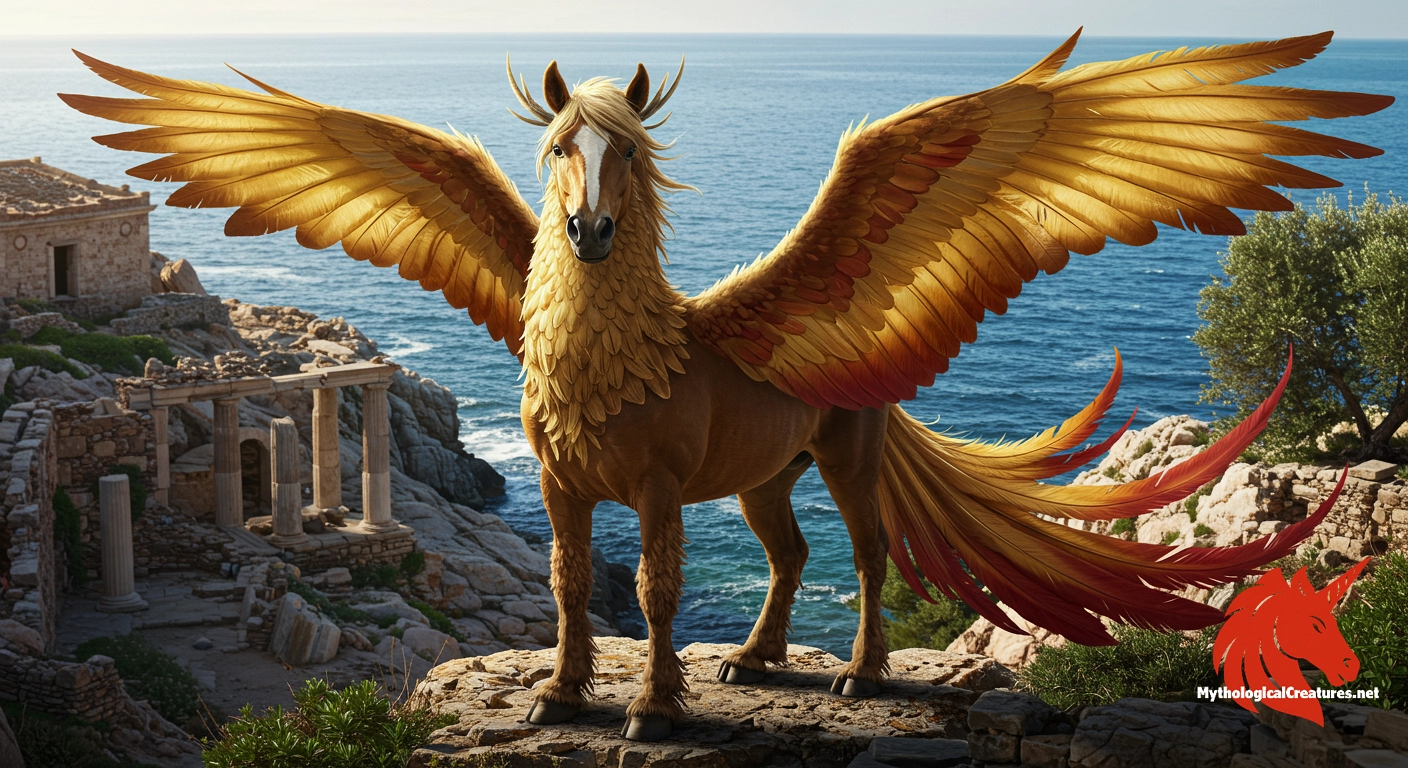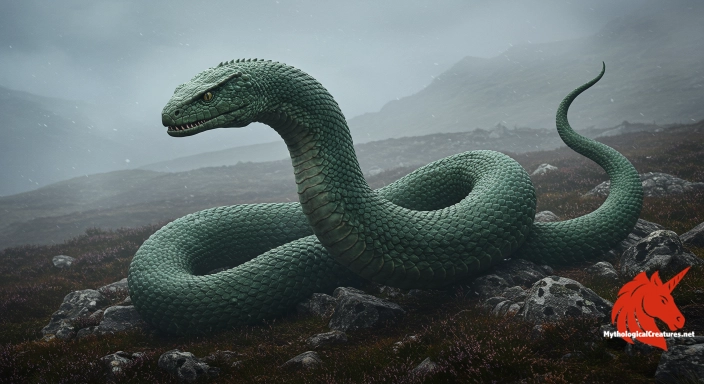Hippalectryon: The Hippalectryon is an ancient Greek hybrid creature featuring the front half of a horse and the hind half of a rooster.

Hippalectryon
Hippalectryon - The Hippalectryon served as a protective symbol, potentially dedicated to Poseidon to safeguard ships, and was widely used in art and literature despite its mysterious role.
Origins & First Encounters
The Hippalectryon is a striking product of ancient Greek mythology, celebrated for its unusual fusion of equine and avian characteristics. Its distinctive form features the front half of a noble horse paired with the hind part of a rooster, creating a dramatic interplay between strength and flamboyance. Early representations of this enigmatic creature date back to the 9th century BCE, marking it as one of the oldest hybrid images in Greek art. By the 6th century BCE, its motif became more common in vase painting and statuary, underscoring its appeal across various cultural contexts. The creature’s vibrant hues, shifting between warm yellow and deep reddish tones, further highlight its captivating nature. Evident in both art and currency, this hybrid also served as an emblem with apotropaic qualities, potentially linked with deities such as Poseidon to safeguard maritime ventures. Despite the absence of extensive mythological narratives, the Hippalectryon continued to resonate as both a decorative and symbolic figure. Its layered imagery invites interpretation that spans notions of protection, divine intervention, and even comic exaggeration, securing its place within the tapestry of ancient Greek folklore. The enduring allure of this fantastical beast demonstrates how even the most puzzling hybrid forms can inspire diverse cultural expressions.
Source Texts & Tale Variants
Ancient Greek artistic sources provide the primary evidence for the existence of the Hippalectryon, with vase paintings and sculptures capturing its unique form in striking detail. Archeological discoveries, including images on coins, reveal that this creature was integrated into everyday visual culture and served multiple symbolic functions. A limited number of literary references from the 5th century BCE also mention the creature, with playwrights like Aeschylus incorporating it into their dramatic lexicon. Aristophanes, known for his biting wit, even employed the Hippalectryon as a pointed insult, demonstrating its dual capacity for awe and humour. The sparse literary mentions, although not forming a coherent narrative, hint at its multifaceted role within ancient Greek society. In several artworks, the creature is depicted alongside riders or maritime idols, suggesting that its purpose extended beyond mere decoration. The diversity of these sources reflects a broader tradition in which visual and verbal accounts intersect to define mythic symbols. While complete mythological stories have not survived, the fragmentary evidence continues to fuel modern reinterpretations. Some lost narratives may well have elaborated further on its protective attributes, adding layers to its enigmatic presence. These varied sources together provide a mosaic of interpretations that enrich our understanding of this ancient hybrid being.
Form & Powers
The Hippalectryon captivates the eye with its remarkable fusion of animal forms, merging the robust elegance of a horse with the vivid, decorative features of a rooster. Its front half is rendered with the muscular precision of a noble steed, exuding both power and refinement. In contrast, the hind half is distinctly avian, complete with wings, intricately feathered details, and a flamboyant tail that draws the viewer’s attention. The creature’s colours, which vary from luminous yellows to intense reddish hues, enhance its surreal appeal and signal a vibrant artistic intent. Artists of antiquity paid close attention to the balance between the solid, grounded nature of the horse and the dynamic, light-footed quality of the rooster. The seamless transition between these elements reflects a sophisticated understanding of both anatomy and symbolism. Intricate depictions reveal textured feathers intermingled with the sinuous lines of equine musculature, suggesting that every detail was designed to evoke a sense of wonder. This unusual physical composition served to challenge perceptions of natural order, blending earthly strength with an airborne, almost otherworldly grace. The careful rendering of its dual features continues to fascinate both scholars and modern artists, underscoring the Hippalectryon’s role as a timeless emblem of creative fusion. Its physical portrayal remains a testament to the ingenuity and imaginative spirit of ancient myth-makers.
Regional Faces
Although the Hippalectryon is fundamentally a product of ancient Greek iconography, its depictions exhibit subtle regional nuances that speak to diverse local traditions. In certain parts of the Greek world, particularly in areas renowned for their vase painting, the creature is portrayed with an emphasis on balanced elegance and refined detail. In other regions, such as coastal centres where maritime symbolism held significant sway, the hybrid is depicted with a more robust and dynamic quality to highlight its protective attributes. Variations in scale, posture, and the rendering of its striking colours reflect local aesthetic preferences and symbolic interpretations. In some local artworks, the addition of a rider or extra embellishments suggests that the creature could be repurposed to serve regional narratives related to guardianship. The use of the Hippalectryon on coins further demonstrates how civic identity and local artistic trends could modify its representation. Despite these regional adaptations, the essential combination of horse and rooster remains a constant, serving as a unifying motif across different communities. The stylistic disparities underscore how localized cultural and artistic priorities can reshape even well-established mythic images. Overall, these regional variations offer a unique lens through which to appreciate how a single mythic motif could be adapted to articulate a diverse spectrum of communal values and beliefs. This adaptability has ensured the creature’s resilient presence across the ancient Mediterranean landscape.
Cultural Parallels
The Hippalectryon occupies a fascinating space within the broader framework of mythological hybridity, drawing parallels with other renowned creatures from ancient lore. Its dual nature, which seamlessly blends the attributes of a horse and a rooster, echoes the thematic contrasts found in figures like the centaur, where human and equine qualities are interwoven. Similar to the griffin—an amalgamation of eagle and lion—the Hippalectryon embodies the idea of merging disparate animal forms to convey both strength and a protective mystique. These hybrid creatures not only defy natural categorisation but also symbolise a fusion of qualities that transcend the ordinary. The integration of flight from the rooster element with the grounded power of the horse suggests a deliberate juxtaposition of heavenly and earthly influences. In various cultures, such composite figures were believed to offer both protective benefits and a challenge to the established order of nature. Modern interpretations of myth often draw from this classical tradition, revisiting such hybrid forms in new creative contexts. The interplay of contrasting features within the Hippalectryon invites comparisons with similar motifs found across the ancient Near East and beyond, where symbolic amalgamations are abundant. This analysis highlights how creatures of mixed genealogy continue to resonate within the cultural imagination, serving as metaphors for complex human experiences. Ultimately, the Hippalectryon stands as a vibrant example of how myth-makers utilised hybridity to articulate nuanced messages about power, protection, and the intermingling of natural forces.
Legacy & Modern Evolution
The historical journey of the Hippalectryon reveals an evolution from a mysterious emblem in ancient art to an enduring figure in modern imaginative expression. Originally depicted on vases, statues, and coins as an apotropaic symbol, the creature was imbued with protective qualities meant to ward off malevolent influences. Over the centuries, its image transformed subtly, shifting from a revered guardian linked to deities such as Poseidon to a subject employed for comic and satirical effect in classical literature. This evolution mirrors changing societal attitudes towards myth, with the creature's once solemn role gradually adopting a more playful or ambiguous tone. While the original mythic narratives have been lost to time, the visual and symbolic legacy of the Hippalectryon persists in various forms of contemporary art and popular culture. Modern artists and designers often draw upon its hybrid form as an inspiration for fantasy landscapes, digital illustrations, and eclectic jewellery designs. Its enduring appeal is not only a testament to the power of classical symbolism but also a reflection of the timeless human fascination with the fusion of disparate natural elements. As academic interest in mythological hybridity grows, the Hippalectryon is frequently revisited in discussions that explore themes of protection, transformation, and the boundary between reality and imagination. Exhibitions and scholarly works continue to highlight its enigmatic presence, ensuring that this ancient creature remains relevant in modern cultural discourses. Today, the Hippalectryon stands as an emblem of creative fusion and enduring mystery, bridging the ancient and the modern in a single, fantastical form.
Interesting Fact
Its unique fusion of horse and rooster elements symbolises a blend of strength and vigilance, making it a fascinating subject in mythological studies.
Quick Creature Info
Origin:
Features:
Associations:
Our Mythic Legendary Rating:

Also Sometimes Known As:
Habitat:
Supernatural Powers:
Physical Attributes:
Abilities:
Behavior:
Lore:
Related Creatures, Tales or Lore
References
Discover Another Mythical Legend You May Not Have Heard Of?
Uncover the mysteries of ancient folklore and expand your knowledge of legendary beings from cultures around the world.
Dare to Meet the Beithir....
Mythical Disclaimer: The images and data on this site are derived from various historical and literary sources, but we have found that many myths often have multiple versions and interpretations across references, sometimes contradictory. As a result, these creature depictions are artistic interpretations—imaginative blends of folklore, legend, and a dash of AI guesswork. Because creature descriptions vary widely, our illustrations and accompanying information represent our best effort to honor mythology while bridging creative gaps. Enjoy these interpretations—just remember, we've done our best to respect the stories and validate available data, but in the realm of mythology, details often shift, imagination leads the way, and nothing is ever set in stone!
Curated by the Mythological Creatures Team (rev. May 2025)
